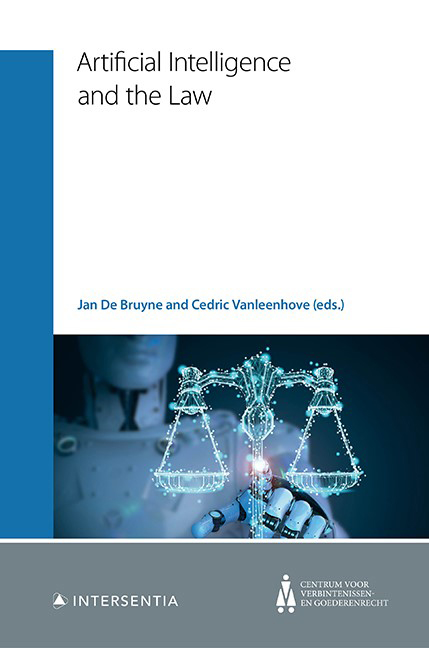Book contents
- Frontmatter
- Contents
- Foreword
- Contributing Authors
- Chapter 1 Basic Concepts of AI for Legal Scholars
- Chapter 2 Different Models of Innovation and Their Relation to Law
- Chapter 3 Setting the Scene: On AI Ethics and Regulation
- Chapter 4 Quantitative Legal Prediction: the Future of Dispute Resolution?
- Chapter 5 AI Arbitrators … ‘Does Not Compute’
- Chapter 6 AI through a Human Rights Lens. The Role of Human Rights in Fulfilling AI’s Potential
- Chapter 7 Killer Robots: Lethal Autonomous Weapons and International Law
- Chapter 8 AI and Data Protection: the Case of Smart Home Assistants
- Chapter 9 AI and IP: a Tale of Two Acronyms
- Chapter 10 Tax and Robots
- Chapter 11 Robotisation and Labour Law. The Dark Factory: the Dark Side of Work?
- Chapter 12 The Hypothesis of Technological Unemployment Caused by AI-Driven Automation and its Impact on Social Security Law
- Chapter 13 AI in Belgian Contract Law: Disruptive Challenge or Business as Usual?
- Chapter 14 Tort Law and Damage Caused by AI Systems
- Chapter 15 Insurance Underwriting on the Basis of Telematics: Segmentation and Profiling
- Chapter 16 AI and Creditworthiness Assessments: the Tale of Credit Scoring and Consumer Protection. A Story with a Happy Ending?
- Chapter 17 AI and the Consumer
- Chapter 18 Robots and AI in the Healthcare Sector: Potential Existing Legal Safeguards Against a(n) (Un)justified Fear for ‘Dehumanisation’ of the Physician-Patient Relationship
Chapter 16 - AI and Creditworthiness Assessments: the Tale of Credit Scoring and Consumer Protection. A Story with a Happy Ending?
Published online by Cambridge University Press: 26 May 2021
- Frontmatter
- Contents
- Foreword
- Contributing Authors
- Chapter 1 Basic Concepts of AI for Legal Scholars
- Chapter 2 Different Models of Innovation and Their Relation to Law
- Chapter 3 Setting the Scene: On AI Ethics and Regulation
- Chapter 4 Quantitative Legal Prediction: the Future of Dispute Resolution?
- Chapter 5 AI Arbitrators … ‘Does Not Compute’
- Chapter 6 AI through a Human Rights Lens. The Role of Human Rights in Fulfilling AI’s Potential
- Chapter 7 Killer Robots: Lethal Autonomous Weapons and International Law
- Chapter 8 AI and Data Protection: the Case of Smart Home Assistants
- Chapter 9 AI and IP: a Tale of Two Acronyms
- Chapter 10 Tax and Robots
- Chapter 11 Robotisation and Labour Law. The Dark Factory: the Dark Side of Work?
- Chapter 12 The Hypothesis of Technological Unemployment Caused by AI-Driven Automation and its Impact on Social Security Law
- Chapter 13 AI in Belgian Contract Law: Disruptive Challenge or Business as Usual?
- Chapter 14 Tort Law and Damage Caused by AI Systems
- Chapter 15 Insurance Underwriting on the Basis of Telematics: Segmentation and Profiling
- Chapter 16 AI and Creditworthiness Assessments: the Tale of Credit Scoring and Consumer Protection. A Story with a Happy Ending?
- Chapter 17 AI and the Consumer
- Chapter 18 Robots and AI in the Healthcare Sector: Potential Existing Legal Safeguards Against a(n) (Un)justified Fear for ‘Dehumanisation’ of the Physician-Patient Relationship
Summary
INTRODUCTION
1. Recently, the availability and variety of innovative technologies, which support the provision of financial services, have increased considerably. Examples thereof range from biometric technology, virtual currencies, artificial intelligence and cloud computing to distributed ledger technology. During the past few years, we have not only been confronted with such terms, but also with the new buzzword ‘FinTech’. FinTech, the abbreviation of ‘Financial Technology’, is defined as ‘technologically enabled financial innovation that could result in new business models, applications, processes or products with an associated material effect on financial markets and institutions and the provision of financial services’. It is, in other words, an umbrella term for all the innovative products, services, processes, functions and distribution channels that have been created in the financial sector in order to respond to the needs of today's consumers. Financial technology – in the shape of algorithms, AI, ML and/or big data analytics – is frequently used when providing consumer credit. Creditors may use financial technology and automation to provide financial advice to the consumer asking for credit, thus guiding them in making a credit decision.
Before concluding a credit agreement, creditors are obligated to perform a thorough assessment of the creditworthiness of said consumer, based on sufficient information obtained from the consumer, where appropriate and on the basis of a consultation of a relevant database, where necessary. This assessment helps them decide whether this individual should be granted credit and allows them to verify whether the consumer will be able to meet his or her (financial) responsibilities under the credit agreement. This obligation to evaluate the financial and personal situation of each consumer who wants to acquire a loan, can be met through automated techniques, which require no or very little human intervention and instead rely on computer-based algorithms. Some of these automated techniques are called ‘credit scoring techniques’.
2 This chapter tries to answer the central question of whether consumer protection is fully guaranteed under the European Consumer Credit Directive, given the new digital reality and the extensive use of credit scoring techniques to assess creditworthiness.
- Type
- Chapter
- Information
- Artificial Intelligence and the Law , pp. 429 - 460Publisher: IntersentiaPrint publication year: 2021



